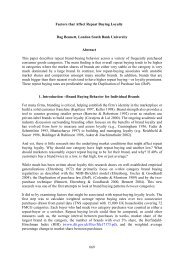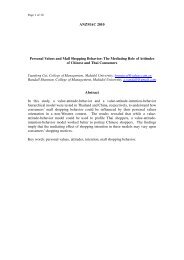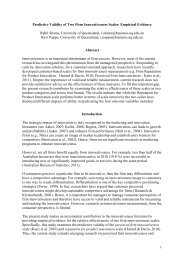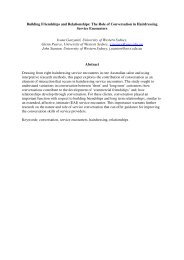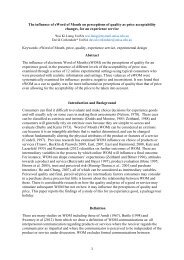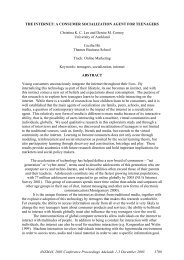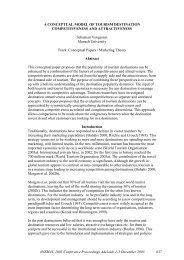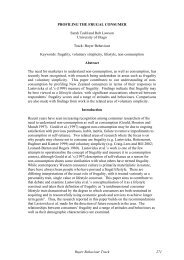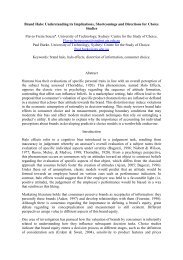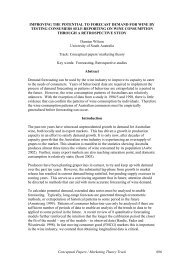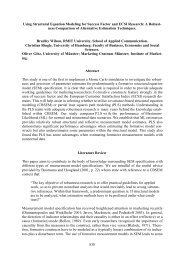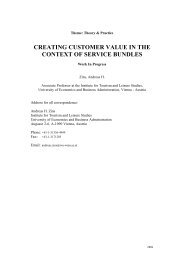Interviewing Young Children: a New Interactive Method - ANZMAC
Interviewing Young Children: a New Interactive Method - ANZMAC
Interviewing Young Children: a New Interactive Method - ANZMAC
You also want an ePaper? Increase the reach of your titles
YUMPU automatically turns print PDFs into web optimized ePapers that Google loves.
Sample<br />
Our sample was composed by 53 children (27 boys and 26 girls) aged 3 to 8 years old. The<br />
average time consumed by children to do the experiment was 5 minutes. While children were<br />
accomplishing their tasks, parents were asked about which of the presented toys children<br />
already had. This information allowed us to measure a possible association between the toys<br />
they would choose and those they already owned.<br />
Analysis of the Data<br />
Although our main goal was not actually to measure children’s preferences regarding toys<br />
and situations, the method outlined allowed us to observe that there is no link between the<br />
toys children already had and those they chose at the screen. They chose those they liked<br />
more independently on the fact of already owning them or not. <strong>Children</strong> choose specific toys<br />
for each specific situation and when they choose the same toys for two different situations,<br />
they do not put them in the same order of preference. There is little difference between boys<br />
and girls regarding the chosen toys, although girls had chosen more dolls and boys more cars.<br />
The most expensive toys are associated with Christmas and their own birthday and children<br />
do not choose the same toys for their own birthday and the friend's one.<br />
Concerning the method itself, which was our main goal for this research, we can say that five<br />
minutes is quick enough to have children motivated and involved. The experiment can even<br />
take longer time if there is a need to add scenarios without children getting annoyed or tired.<br />
They actually asked for more after the exercise was over. Using their own language allowed<br />
them to autonomously participate to the interviews. No adults were called to help. Moreover,<br />
using a computer screen and representing the contents by visual elements let children think<br />
about a game they were willing to play. At the beginning, we aimed to compare the results of<br />
the interactive method with those from a smiling faces scale interview, but we realized that if<br />
we wanted to analyze 12 toys in 5 scenarios, the questionnaire would be too long, mainly if<br />
we also aimed to measure the order of their preferences in each scenario. Therefore, we<br />
decided not to compare both methods and concentrate in the interactive one.<br />
Research Limitations and Implications<br />
The level of knowledge children should have concerning computer and mouse manipulation<br />
can introduce a bias in their responses. Computers are needed to carry out the research.<br />
Moreover, it is tough to measure the reliability of a computer based measurement tool, as<br />
young children, attracted by the forms and colors of some toys, could randomly click in some<br />
of them. The interactive method was used to measure children preferences of toys regarding<br />
specific situations. This same method can allow researchers to measure brand and logo<br />
recognition, pre-testing packaging, logos, brand names, characters. This can also allow<br />
children to create marketing elements by placing shapes, colors, designs, etc. Moreover,<br />
sending the software by internet allows companies and researchers to cover big samples with<br />
small costs. Finally, it is an appropriate method for cross-cultural research, as only the off<br />
voice should be adapted.<br />
695



